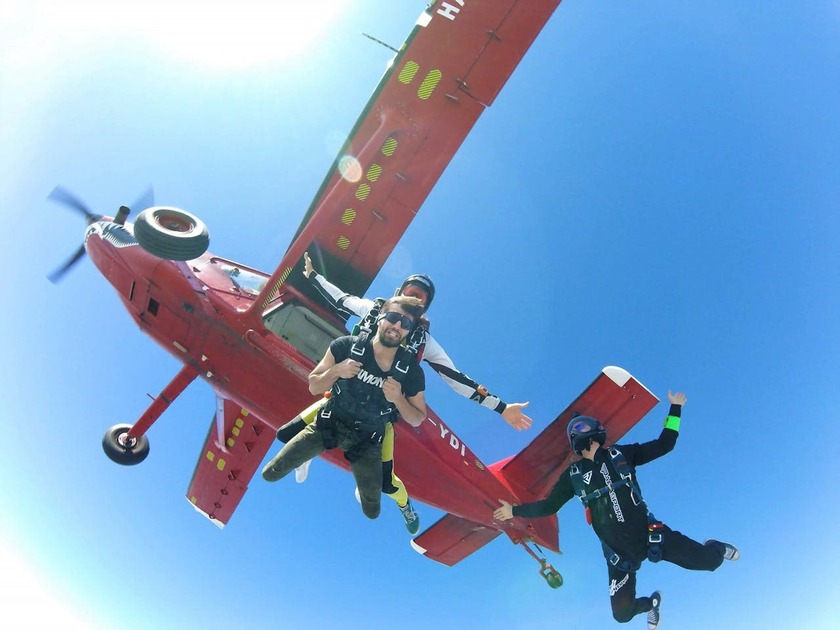Skydiving is one of the most thrilling and unforgettable experiences on the planet. Whether you’re taking your first tandem jump or planning to pursue skydiving as a sport, knowing how to prepare is essential for both safety and confidence. In this guide, we’ll walk you through everything you need to mentally and physically train for your first skydive, plus how to capture the moment with the best action camera.
1. Mental Preparation: Conquering the Fear of Jumping

Skydiving is just as much a mental challenge as it is a physical one. Here’s how to train your mind before the big day.
Understand the Safety Measures
- Tandem skydiving has an extremely low risk due to modern parachute technology and expert instructors.
- Every tandem jump includes a backup parachute and an automatic activation device (AAD) for extra safety.
Visualize the Jump
- Watching first-person skydiving videos can help you get familiar with the experience.
- Mental visualization of stepping out of the plane, feeling the freefall, and experiencing the parachute deployment helps reduce anxiety.
Practice Controlled Breathing
- Many first-time jumpers experience sensory overload. Deep breathing techniques help you stay calm and fully enjoy the moment.
Book your first tandem skydive:
GetYourGuide Skydiving Experience
Viator Tandem Skydiving Packages
2. Physical Training: Get Your Body Ready for Freefall

While skydiving doesn’t require elite fitness, some basic training will help you handle freefall more comfortably.
Strengthen Your Core
A strong core helps control body position in freefall. Recommended exercises include:
- Planks
- Leg raises
- Bicycle crunches
Improve Your Flexibility
Skydiving requires maintaining an arched body position and lifting your legs before landing. Key stretches include:
- Lower back flexibility exercises
- Hamstring stretches
- Yoga poses for spinal mobility
Train for Short Bursts of Adrenaline
Freefall lasts around 45-60 seconds, and your body will experience an intense rush of adrenaline. High-intensity interval training (HIIT) or sprint drills can help your body adapt to these short bursts of extreme activity, improving endurance and reaction time.
Skydiving over breathtaking locations like Queenstown adds to the thrill, making the experience even more unforgettable. If you’re looking for the ultimate adventure, check out our Queenstown Adventure Guide for more on extreme sports in New Zealand.
Book your tandem jump now:
GetYourGuide Skydiving Experiences
Viator Tandem Skydiving Packages
3. Skydiving Techniques: What to Practice Before the Jump

Your skydiving instructor will guide you through the process, but practicing these basic techniques beforehand will improve your confidence.
The Arch Position (Belly-to-Earth Freefall)
- Keep your head up, hips forward, and back slightly arched.
- Spread your arms and legs evenly for stability.
The Safe Landing Position
- Before landing, lift your legs parallel to the ground to help the instructor manage the landing safely.
Experience Freefall Before Jumping (Wind Tunnel Training)
Indoor skydiving simulates real freefall conditions in a safe, controlled environment. This is a great way to practice freefall stability and control before your actual jump.
Book an indoor skydiving experience:
Viator Indoor Skydiving
4. What to Eat & Wear for Your First Skydive

- Fuel Up Smartly: Eat a light, balanced meal before your jump to avoid dizziness. Avoid heavy, greasy foods or excessive caffeine.
Best Clothing for Skydiving
- Fitted athletic wear (leggings, fitted shirts, or jumpsuits)
- Lace-up sneakers (avoid boots or sandals)
- Layers for warmth if jumping in colder conditions
What NOT to Wear
- Loose clothing or accessories that could get tangled
- Jewelry or valuables that could fall off during freefall
5. Safety & Equipment: Understanding the Gear

Even though your instructor will handle most of the technical aspects, it’s helpful to familiarize yourself with skydiving gear:
- Parachute System: This system consists of a main parachute, a reserve parachute, and an automatic activation device (AAD).
- Jumpsuit & Helmet: Protects against wind resistance and provides added comfort.
- Altimeter: Measures altitude and helps with parachute deployment timing.
6. Capture Your Skydiving Experience: Best Action Camera to Use

Skydiving is a once-in-a-lifetime experience; having a high-quality action camera lets you relive it forever.
Best GoPro for Skydiving: GoPro HERO12 Black
This is the top choice for skydivers due to its:
- HyperSmooth 5.0 stabilization for steady footage
- 4K 120FPS recording for ultra-clear slow-motion shots
- Wind noise reduction for crisp audio in freefall
- Helmet and wrist mount compatibility for hands-free filming
Get your skydiving camera here:
GoPro HERO12 Black on Amazon
Note: Some skydiving centers don’t allow personal cameras for safety reasons. Many offer professional photo/video packages to capture the moment.
Conclusion: Take the Leap
Your first skydive will be one of the most unforgettable moments of your life. By preparing mentally and physically, practicing freefall techniques, and using the right gear, you’ll make the most of your jump.
Book Your Skydiving Adventure:
GetYourGuide Skydiving Packages
Viator Tandem Skydiving Experiences
Best GoPro for Skydiving on Amazon



